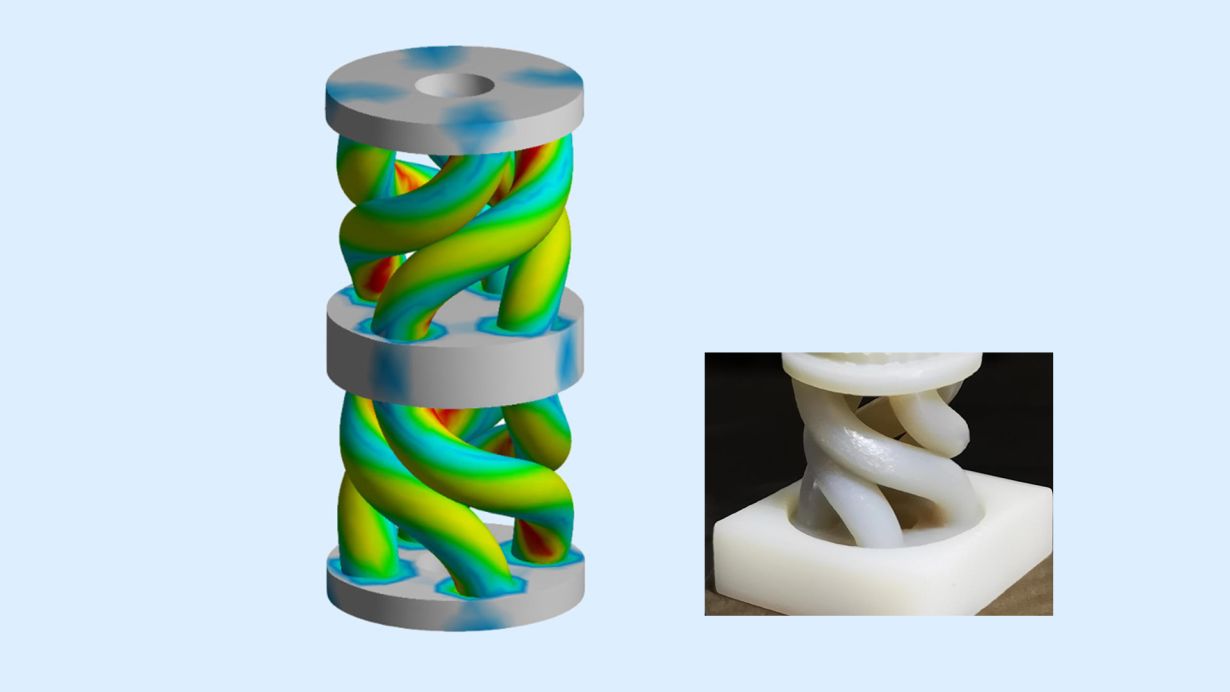
An international research team coordinated at KIT (Karlsruhe Institute of Technology) has developed mechanical metamaterials with a high elastic energy density. Highly twisted rods that deform helically provide these metamaterials with a high stiffness and enable them to absorb and release large amounts of elastic energy. The researchers conducted simple compression experiments to confirm the initial theoretical results. Their findings have been published in the science journal Nature. (DOI: 10.1038/s41586-025-08658-z)
Be it springs for absorbing energy, buffers for mechanical energy storage, or flexible structures in robotics or energy-efficient machines: Storage of mechanical energy is required for many technologies. Kinetic energy, i.e. motion energy or the corresponding mechanical work, is converted into elastic energy in such a way that it can be fully released again when required. The key characteristic here is enthalpy - the energy density that can be stored in and recovered from an element of the material. Peter Gumbsch, Professor for mechanics of materials at KIT's Institute for Applied Materials (IAM), explains that achieving the highest possible enthalpy is challenging: "The difficulty is to combine conflicting properties: high stiffness, high strength and large recoverable strain."
Clever Arrangement of Helically Deformed Rods in Metamaterials
Metamaterials are artificially designed materials that do not occur in nature. They are assembled from individually defined units so that their effective material properties can be enhanced. Peter Gumbsch, who also heads the Fraunhofer Institute for Mechanics of Materials IWM in Freiburg, and his international research team with members from China and the USA now succeeded in developing mechanical metamaterials with a high recoverable elastic energy density. "At first, we detected a mechanism for storing a high amount of energy in a simple round rod without breaking it or deforming it permanently," says Gumbsch. "By defining a clever arrangement of the rods, we then integrated this mechanism into a metamaterial."
The scientists compare this mechanism to a classic bending spring, whose maximum deformation is limited by high tensile and compressive stresses that occur at its top and bottom surfaces and lead to breaking or permanent plastic deformation. In such a bending spring, the stresses on the entire inner volume are very low. However, if a rod is twisted instead its entire surface is also exposed to high stresses but the interior volume at low stresses is considerably smaller. To leverage this mechanism, the torsion must be so high that it results in a complex helical buckling deformation.
Enthalpy Is 2 to 160 Times Higher Than in Other Metamaterials
The researchers managed to integrate such torsionally loaded and helically deformed rods into a metamaterial that can be used macroscopically under uniaxial loads. Simulations helped them predict that the metamaterial would have a high stiffness and thus could absorb large forces. In addition, its enthalpy is 2 to 160 times higher than that of other metamaterials. To confirm this, they conducted simple compression experiments on various metamaterials with mirrored chiral structures.
"Our new metamaterials with their high elastic energy storage capacity have the potential to be used in various areas in the future where both efficient energy storage and exceptional mechanical properties are required," says Gumbsch. Conceivable applications beside spring-based energy storage include shock absorption or damping as well as flexible structures in robotics or in energy-efficient machines. Alternatively, the twists occurring inside the metamaterials might be used for purely elastic joints. (or)
Original publication:
Xin Fang, Dianlong Yu, Jihong Wen, Yifan Dai, Matthew R. Begley, Huajian Gao & Peter Gumbsch: Large recoverable elastic energy in chiral metamaterials via twist buckling. Nature, 2025. DOI: 10.1038/s41586-025-08658-z
https://www.nature.com/articles/s41586-025-08658-z
More information on the KIT Center "Materials in Technical and Life Sciences (MaTeLiS)"
Being "The Research University in the Helmholtz Association", KIT creates and imparts knowledge for the society and the environment. It is the objective to make significant contributions to the global challenges in the fields of energy, mobility, and information. For this, about 10,000 employees cooperate in a broad range of disciplines in natural sciences, engineering sciences, economics, and the humanities and social sciences. KIT prepares its 22,800 students for responsible tasks in society, industry, and science by offering research-based study programs. Innovation efforts at KIT build a bridge between important scientific findings and their application for the benefit of society, economic prosperity, and the preservation of our natural basis of life. KIT is one of the German universities of excellence.






